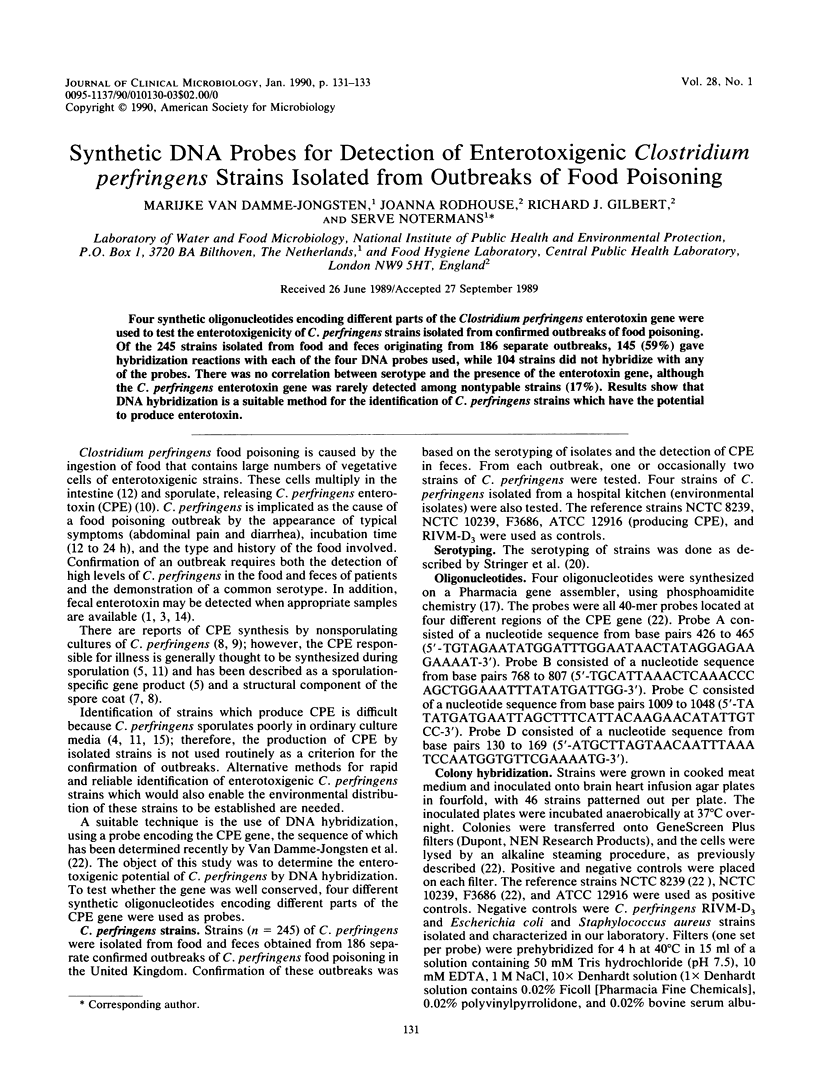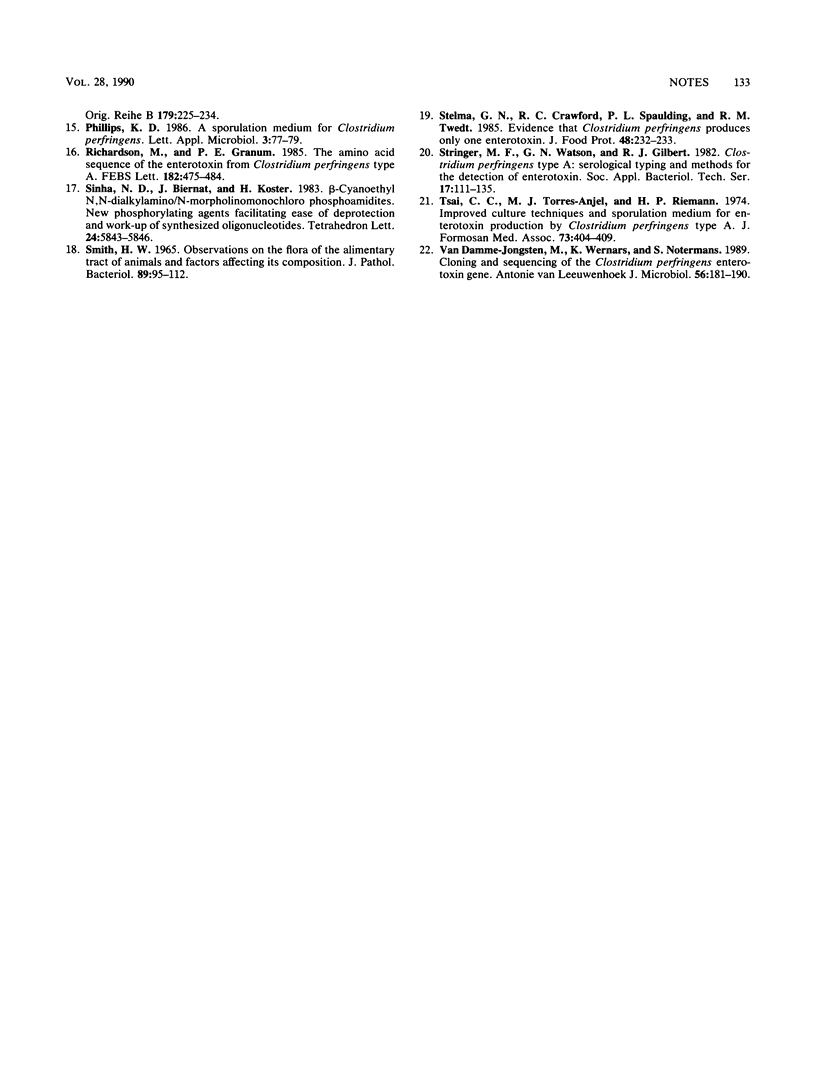Abstract
Four synthetic oligonucleotides encoding different parts of the Clostridium perfringens enterotoxin gene were used to test the enterotoxigenicity of C. perfringens strains isolated from confirmed outbreaks of food poisoning. Of the 245 strains isolated from food and feces originating from 186 separate outbreaks, 145 (59%) gave hybridization reactions with each of the four DNA probes used, while 104 strains did not hybridize with any of the probes. There was no correlation between serotype and the presence of the enterotoxin gene, although the C. perfringens enterotoxin gene was rarely detected among nontypable strains (17%). Results show that DNA hybridization is a suitable method for the identification of C. perfringens strains which have the potential to produce enterotoxin.
Full text
PDF


Selected References
These references are in PubMed. This may not be the complete list of references from this article.
- Bartholomew B. A., Stringer M. F., Watson G. N., Gilbert R. J. Development and application of an enzyme linked immunosorbent assay for Clostridium perfringens type A enterotoxin. J Clin Pathol. 1985 Feb;38(2):222–228. doi: 10.1136/jcp.38.2.222. [DOI] [PMC free article] [PubMed] [Google Scholar]
- Dowell V. R., Jr, Torres-Anjel M. J., Riemann H. P., Merson M., Whaley D., Darland G. A new criterion for implicating Clostridium perfringens as the cause of food poisoning. Rev Latinoam Microbiol. 1975 Jul-Sep;17(3):137–142. [PubMed] [Google Scholar]
- Duncan C. L., Strong D. H. Improved medium for sporulation of Clostridium perfringens. Appl Microbiol. 1968 Jan;16(1):82–89. doi: 10.1128/am.16.1.82-89.1968. [DOI] [PMC free article] [PubMed] [Google Scholar]
- Duncan C. L., Strong D. H., Sebald M. Sporulation and enterotoxin production by mutants of Clostridium perfringens. J Bacteriol. 1972 Apr;110(1):378–391. doi: 10.1128/jb.110.1.378-391.1972. [DOI] [PMC free article] [PubMed] [Google Scholar]
- Feinberg A. P., Vogelstein B. A technique for radiolabeling DNA restriction endonuclease fragments to high specific activity. Anal Biochem. 1983 Jul 1;132(1):6–13. doi: 10.1016/0003-2697(83)90418-9. [DOI] [PubMed] [Google Scholar]
- Frieben W. R., Duncan C. L. Heterogeneity of enterotoxin-like protein extracted from spores fo Clostridium perfringens type A. Eur J Biochem. 1975 Jul 1;55(2):455–463. doi: 10.1111/j.1432-1033.1975.tb02182.x. [DOI] [PubMed] [Google Scholar]
- Frieben W. R., Duncan C. L. Homology between enterotoxin protein and spore structural protein in Clostridium perfringens type A. Eur J Biochem. 1973 Nov 15;39(2):393–401. doi: 10.1111/j.1432-1033.1973.tb03137.x. [DOI] [PubMed] [Google Scholar]
- Goldner S. B., Solberg M., Jones S., Post L. S. Enterotoxin synthesis by nonsporulating cultures of Clostridium perfringens. Appl Environ Microbiol. 1986 Sep;52(3):407–412. doi: 10.1128/aem.52.3.407-412.1986. [DOI] [PMC free article] [PubMed] [Google Scholar]
- Maxam A. M., Gilbert W. Sequencing end-labeled DNA with base-specific chemical cleavages. Methods Enzymol. 1980;65(1):499–560. doi: 10.1016/s0076-6879(80)65059-9. [DOI] [PubMed] [Google Scholar]
- Richardson M., Granum P. E. The amino acid sequence of the enterotoxin from Clostridium perfringens type A. FEBS Lett. 1985 Mar 25;182(2):479–484. doi: 10.1016/0014-5793(85)80358-6. [DOI] [PubMed] [Google Scholar]
- SMITH H. W. OBSERVATIONS ON THE FLORA OF THE ALIMENTARY TRACT OF ANIMALS AND FACTORS AFFECTING ITS COMPOSITION. J Pathol Bacteriol. 1965 Jan;89:95–122. [PubMed] [Google Scholar]
- Tsai C. C., Torres-Anjel M. J., Riemann H. P. Improved culture techniques and sporulation medium for enterotoxin production by Clostridium perfringens type A. Taiwan Yi Xue Hui Za Zhi. 1974 Jul;73(7):404–409. [PubMed] [Google Scholar]
- Van Damme-Jongsten M., Wernars K., Notermans S. Cloning and sequencing of the Clostridium perfringens enterotoxin gene. Antonie Van Leeuwenhoek. 1989 Aug;56(2):181–190. doi: 10.1007/BF00399981. [DOI] [PubMed] [Google Scholar]


